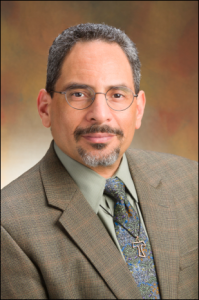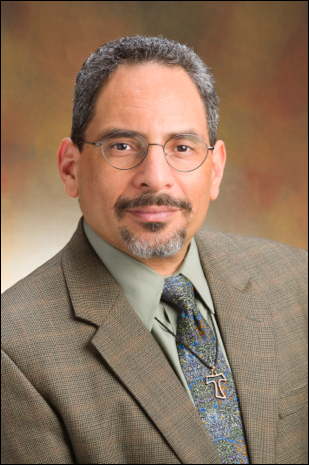More Light at the Intersection: A Case Study – Tony De La Rosa
 We return again to my home congregation. From my previous description, it should be clear that we are not adverse to change. Indeed, like all resilient communities of faith, it is our willingness to accept change – deep adaptive change, at that – that has permitted us to survive huge demographic shifts in our inner-city neighborhood.
We return again to my home congregation. From my previous description, it should be clear that we are not adverse to change. Indeed, like all resilient communities of faith, it is our willingness to accept change – deep adaptive change, at that – that has permitted us to survive huge demographic shifts in our inner-city neighborhood.
Over the 126 years of our existence, my church has seen our city grow from a small, mostly agricultural town to a sprawling metropolis. By the 1990s, our membership dwindled to a few mostly elderly stalwarts who recognized that something different had to be done. So the church called a pastor with Spanish-English bilingual skills and pan-Latin American cultural sensitivity to reach out to the inner-city community of Latino immigrant families virtually on our doorstep. Gradually, the congregation grew. I joined during this time in its history.
I learned then that the church had had a history of quietly welcoming lesbian and gay persons into membership and including them as church officers and staff. That welcome had beneficial side effects. Secular administration of the church, including its finances and property, had been in the hands of a capable gay executive for almost ten years. The youth program, led by an openly lesbian former television actress and professional photographer, had embarked on a ground-breaking, multi-year project teaching our youth to photograph their surroundings, culminating in an annual formal gallery exhibition of the results. In addition, our music program was also exceedingly accomplished and included several openly gay musicians and worship leaders. It became clear to me, if not to others as well, that this level of LGBTQ participation and engagement was crucial to the church’s ongoing operations and mission. Take away the LGBTQs, and the church would simply cease to function. For many in the congregation, LGBTQ witness was a substantive part of the entire church experience.
As the church’s membership continued to diversify, LGBTQ visitors found the church a place of welcome and visibility, and joined as members. Although the total LGBTQ membership was never a substantial percentage of the whole body, hovering around 5%, they tended to be a disproportionally involved in church activities, volunteering as ushers, choir members, mission volunteers and church officers. Perhaps because of this high degree of church involvement, there was no separate social support group for LGBTQ members or affiliates. Socialization within the LGBTQ group did occur, certainly, but there was no programmatic gathering specifically intended to provide social connection or “safe space.” The church itself was “safe space,” and while it did not proclaim that fact, it did not hide it either.
Finally, the LGBTQ presence was not limited to a single ethnicity or language constituency within the congregation. There were individual LGBTQs among both our English and Spanish-speaking worshippers, present in varying degrees of openness about their identity. There was no formal poll or vote wherein the prevailing sentiment of the congregation’s constituents on LGBTQ inclusion could be discerned. While there were unquestionably conservative members within both groups opposed to the presence of LGBTQs in the church, they did not attempt to interfere with the congregation’s embrace of its new members, and they often served alongside them in church events, activities, and governing bodies.
Of the committed LGBTQ couples connected to the church in some way, a number were ethnically mixed. One fascinating dynamic about the LGBTQs in committed relationships deserves mention: if one in the couple were a formal church member, the other most likely would not be; however, the non-churched frequently would be as easily socialized into church life as their member partners.
To summarize then, my home church:
- Had historically – if quietly – integrated LGBTQs into the programmatic leadership;
- Welcomed LGBTQs without creating a separate or formal social support group; and
- Encountered the same ethnic diversity amongst the LGBTQs members (and their partners) that characterized the congregation as a whole.
These three characteristics set the stage for the church’s consideration of becoming an official More Light congregation[1]. Although the approval of More Light status was within the session’s authority, a decision was made to involve the congregation as a whole in an attempt to gain as broad a consensus as possible.
Several attempts were made at educating and engaging the congregation in examining More Light status. The process would begin, but some other more pressing and overarching issue or concern would divert attention and energy away of the project. Beginning in about 2006 and 2007, pastoral leadership and elders on session aligned to undertake listening sessions with the congregation on the larger issues of LGBTQ inclusion in general and the possible official adoption of a More Light statement in particular.
The congregational listening sessions were revealing. Designed as bilingual studies of key bible passages seen as impacting Christian stances on homosexuality, the discussions would gravitate to reflections on personal histories and experiences. The intimacy and sensitivity with which these discussions were held were extraordinary, even within a faith community as close and tight-knit as ours. Stories of love, loss, separation and even violence poured out. Tears were shed, and wounded hearts exposed. Both those supportive and those opposed shared their grief, not reaching resolution of their differences but reaching some pain-filled understanding of each other.
There was never any question in my mind that a clear majority of the elders on the Session were in favor of More Light status, but they took their leadership responsibilities seriously and actively participated with the rest of the congregation in the listening sessions. As the Clerk of Session, I was reasonably attuned to the sentiments and leanings of our pastors and session elders. The real question was how much of a bilingual consensus could be garnered and whether or not the vote would be a narrow one. I also knew that there were some whose opinions were not shared publicly and were uncomfortable at the thought that they would have to make their view a public witness.
By June 2008, having conducted a number of listening sessions with the congregation, the session was ready to decide. At a regular stated meeting that month, the session began with consideration of a series of reports about our building and grounds (there was always something else to act upon), and then proceeded to deliberate on a resolution declaring our church to be a More Light congregation. Out of deference to those who wished to keep their views private, I requested that the vote be taken by secret ballot. I need not have taken that step, because every member spoke up in the discussion. Some declared their absolute unflagging support, others spoke about their reservations, and still others worried about how some in the congregation might react. As the ballots were distributed, we prayed, and asked for God’s guidance.
When the ballots were tallied, the vote was nearly unanimous. Elders voting in the affirmative included three Asians (two Filipinos, one Korean), five Hispanics (three Mexicans, one Puerto Rican, and one Panamanian), and four Anglo-Americans. Included among these elders voting in favor were three gay males. There was only one “no” vote from a Hispanic (Salvadoran) female elder, who later agreed to support the decision of the body. (For the record, one of the absent elders who held the heterosexual, white, married, male “affirmative action” slot had written his colleagues beforehand, apologizing for his being unable to be present, and urging them to support the More Light resolution. He did a fine job.) We immediately acted on a series of enabling motions, including publication of our action in worship bulletins and other media, and development of a communications plan for members of the congregation and for our mission partners.
Our next decision, however, proved to be the more momentous. By quirky providence, the California Supreme Court’s initial ruling granting same-sex couples the right to marry had taken effect the very same day of the session’s meeting: June 17, 2008. Now that we had decided that we were to be known as a More Light church, the question turned to how we would respond to the turn of events that day. Specifically, would same-sex couples be permitted to marry in our facilities? Our church building was already the rehearsal location for the 200-member gay men’s chorus; many remarked that we received more LGBTQ foot traffic in an average week than just about any other venue in the city! Would we accept persons wishing to access the facilities they lovingly knew and used to formalize their commitments to one another?
A motion was introduced to permit same-sex marriages with the same conditions and guidelines governing all other marriages in our building. There were clear differences in the minds of session members on this issue. Unlike the more generally worded More Light resolution, an action expressly permitting same-sex marriages to take place in our buildings carried the risk of disciplinary sanction from the denomination. Such marriages were receiving high degrees of press coverage, and the perils to our governance and mission were considerable. Deliberation on this subject took a far more concerned and impassioned tone, with discernible conflict among the Hispanic elders. Again, a secret ballot vote was taken, and the results were more divided than on the More Light resolution: 7 in favor, 4 opposed, and 2 abstentions. Unlike the first vote, ethnic breakdowns of the marriage vote were hard to discern.
In the votes’ aftermath, our church dealt with the More Light designation with a surprisingly non-anxious response. Obviously, there were persons opposed, but they remained a part of the community through the next crisis that confronted us. There was always something else to distract us.
Today, we hang the rainbow flag from our flagpole in front of our building, reminding all of us that the promises of God are open to all of God’s people.
Ruling Elder Tony De La Rosa is the former Interim Executive Presbyter of the Presbytery of New York City. Prior to his work in New York City, Tony served as the Associate Counsel and Director of Board Administration of L.A. Care Health Plan, the nation’s largest public HMO, with over 1.2 million Medicaid, S-CHP and Medicare members. In the 1990s, Tony was the Executive Director of the Los Angeles Center for Law and Justice, legal services agency dedicated to addressing pressing advocacy needs for the predominantly Latino communities of East and Northeast Los Angeles.
A lifelong Presbyterian, Tony is the former Clerk of Session at Immanuel Presbyterian Church of Los Angeles, and he has volunteered for over 20 years on various General Assembly-level entities, including the Advisory Committee on Litigation (as a charter member), the Special Committee on Church-wide Compensation Policy Guidelines, and more recently on the Special Committee to Study Issues of Civil Union and Christian Marriage that reported to the 219th General Assembly in 2010. Most recently, he joined the Board of Pensions as a Director in 2012. Tony received his Bachelor of Arts, Master of Divinity and Juris Doctor degrees from Yale University. He and his partner of seven years, Michael Bendgen, currently reside in Los Angeles.
[1] The designation “More Light” signifies affiliation with More Light Presbyterians (“MLP”), a pro-LGBTQ affinity group within the Presbyterian Church (U.S.A.). MLP’s current Mission Statement reads:
Following the risen Christ, and seeking to make the Church a true community of hospitality, the mission of More Light Presbyterians is to work for the full participation of lesbian, gay, bisexual, transgender and queer (LGBTQ) people in the life, ministry and witness of the Presbyterian Church (USA) and in society.

